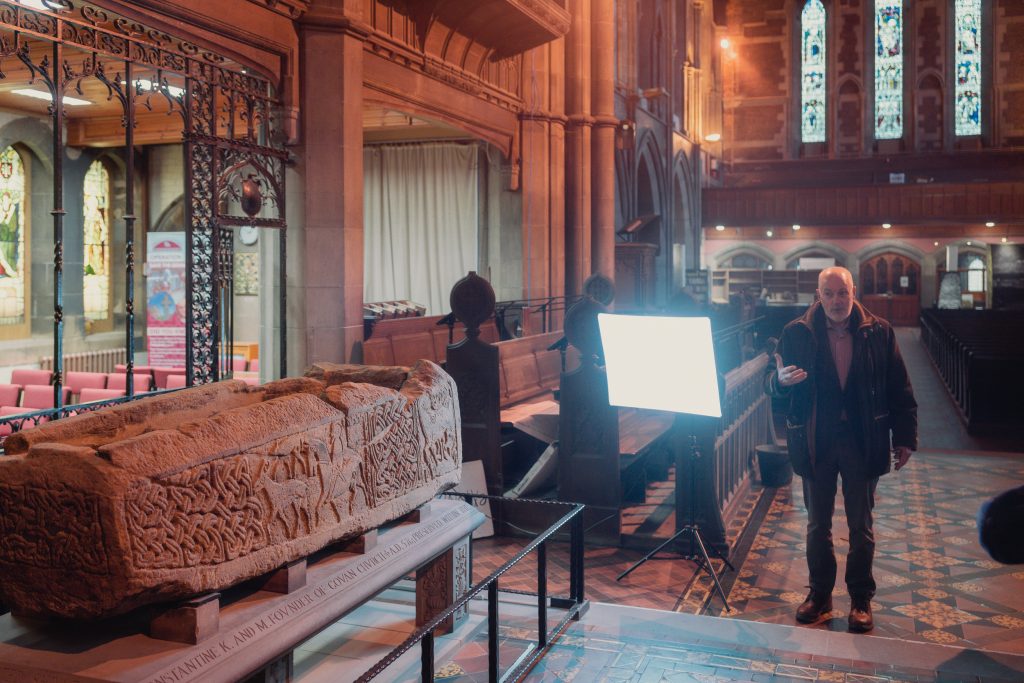
Gaston Welisch is the Community Innovation Practitioner for the Arts & Humanities Partnership Catalyst, a Glasgow-based collaboration between the University of Glasgow and the Glasgow School of Art. After engaging with communities on themes such as Digital Cultural Heritage, Scottish Food Culture, and Mental Health and Wellbeing, the team are embarking on their fourth interdisciplinary project: a place-based inquiry into the context of Govan, with a particular focus on the Govan Old Church.
On a rainy February morning, my colleagues from the Catalyst and I went on a guided visit of the historic site of Govan Old Church with archaeologist Prof Stephen Driscoll. The exploration of this significant landmark marks the beginning of a series of workshops aimed at connecting the archaeological work of Prof. Driscoll with the communities needs and envisaged Futures of Govan.
The concept of ‘Little Futures‘ will serve as the framework for the first step of our initiative. ‘Little Futures’ emphasises the significance of localised, small-scale narratives and projects as core constituents of the broader ‘Big Futures’. Govan Old, with its historical resonance and untapped potential, embodies an ideal ‘Little Future’, offering a wide array of local possibilities that can significantly contribute to the overarching narrative of Govan’s ‘Big Futures’.

The visit meant we got to admire the Govan Stones, a remarkable collection of early medieval sculpture that embody the legacy of the Kingdom of Strathclyde. Dating back to as early as the 9th century, and primarily used for burial, they show the historical significance of Govan Old and the enduring value of the site as a centre of spiritual and temporal authority. Additionally, the historical connection between Govan and the University of Glasgow, dating back to the sixteenth century, emerged as a particularly compelling narrative thread. This relationship, fortified through the annexation of Govan parish, bolstered the university’s financial foundation – this is perhaps a bond worth revisiting, almost a spiritual debt to be paid back.
The forthcoming workshops are envisioned as a collaborative platform to delve into Govan Old’s potential and explore its role in shaping the ‘Big Future’ of Govan. By engaging with the community and stakeholders, we aim to co-create a vision that harnesses the site’s heritage. The concept of ‘Little Futures’ allows for the acknowledgment and incorporation of localised initiatives and narratives into the broader vision of urban renewal and community development.


The trialling of micro-catalysts (alongside our usual method of hosting larger workshops), inspired by the Situationist concept of the “dérive” is a new experiment in our approach. These psychogeographical walks will encourage participants to view Govan through a new lens, guided by emotional and sensory responses to the surroundings. By breaking from routine and engaging with the environment in a reflective manner, we aim to uncover the emotional and social contours that define Govan. This methodology will facilitate a more embodied understanding of the community’s aspirations and challenges.
Our approach to the workshops will be structured around three key stages: Assets, Associate, and Assemble, which I’ve started theorising as the Triple A Model. Each stage is designed to progressively build upon the insights and collaborations established in the preceding phase, culminating in a cohesive action plan that reflects a shared vision for Govan Old and its community. Whereas this Catalyst is more people-driven, past catalysts have been more project-driven, perhaps reflecting a different set of Triple As: Assets, Augment, Actions. This model is still a work in progress and I’m keen to compare and assess what has made our approach work across different contexts.
Assets: This initial phase focuses on articulating the existing assets, relationships, and ideas cultivated through Govan Old and its partners. Through a collaborative working group, we aim to map out these elements as ‘little futures’ and discuss potential initiatives to be opened up and aligned with wider communities.
Associate: The second phase aims to share and connect Govan Old’s ‘little futures’ vision with a broader network of stakeholders and their ‘little futures’. By showcasing a collection of future visions and facilitating discussions, we aim to identify synergies and co-create narratives that resonate with the collective aspirations of the Govan community.
Assemble: The final phase is dedicated to refining the collective vision into a detailed action plan. By engaging in co-design processes, participants will develop concrete strategies and initiatives that embody preferred Futures for Govan Old and its associated communities through identified collaborations.
Our exploratory visit to Govan Old, in collaboration with Prof. Stephen Driscoll, has laid the groundwork for the upcoming series of workshops. By leveraging the concept of ‘Little Futures’, we endeavour to co-create narratives that leverage Govan Old’s heritage and imagine creative pathways for community development. Through the integration of micro-catalysts and walk-based methodologies, we seek to engage with the community in a manner that is both embodied and experiential – proposing creative ways of socioecological knowing.
Thanks to Dr Neil McIntyre for the details about Govan Old Parish. Gaston Welisch is a Community Innovation Practitioner from the 2023-2024 cohort. You can find out more about his work on our website or read about the CIP Pilot.
Brought to you by


